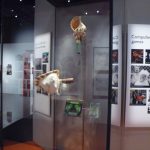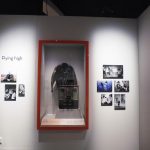Volume: Making Music in Aotearoa
Volume: Making Music in Aotearoa
‘ Volume : Making Music in Aotearoa’ has been over two years in development, a joint venture between the Auckland Museum and the NZ Music Hall of Fame.
Auckland War Memorial Museum October 2016 – May 2017
‘Volume’ is many things: interactive, fun and often insightful, taking you back in time from now (2000s) to then (1950s) as you wend your way through, ending with the obligatory shop, and a photographic ‘wall of fame’ of musicians and bands before you exit.
The exhibition uses stage costumes, instruments, mixing desks, amplifiers, documentaries, a digital C’mon TV set, a re-imagined pub stage, and curated playlists to tell the intertwining stories of the NZ music scene, and does so with a eye to preserving experiences.
The impact is immediate, especially relating to how the over 200 items are presented, and one of the biggest comes from the actual displays. For example, song lyrics to Anika Moa’s My Old Man float in a display case – a beautiful representation of a highly personal song.
Song lyrics are peppered throughout the exhibition, including Bic Runga’s Drive and Don’t Dream It’s Over by Crowded House, and these puncture the polished, often commercial feel with the original creative moment on paper. Don’t Dream It’s Over in particular is an ‘ahh’ moment, and the centre of the ‘wall of Finn’ (an obvious addition, and significant tribute), which includes a silent home film of a young Tim and Neil Finn performing for family members, family photographs, Neil Finn’s guitar and a Finn family guitar case.
The highlights continue throughout as you make your way through the decades: Split Enz’ stage costumes designed by Noel Crombie, the wall of 10 guitars, Andrew Fagan’s pink fake fur stage outfit, the Topp Twins’ knitted dolls, Martin Phillipps’ leather jacket, Chris Knox’s portable 4-track recorder, a display dedicated to Moana Maniapoto, Lorde’s Grammy award and the outfit she wore to accept the Grammy… and of course, more guitars and more costumes. Bill Sevesi’s steel guitar has pride of place, as do examples of taonga pūoro (traditional Māori instruments), The wall of Chris Knox is pretty impressive too.
Wall displays also celebrate Dalvanius Prime, Johnny Cooper and the Maori Showbands, bringing their stories to life, though leaving you wanting more – always the case with exhibitions like these. It’s an Aladdin’s Cave of riches of NZ music history.
Well thought out interactive elements are one point of difference to this exhibition. Ukuleles can be taken off a wall and played, while one of the best parts is being able to get up replicate the band experience performing in a pub, playing instruments while facing a digital audience – loads of fun, especially if you’re with kids who want to play the drums loud! Spinning poi while listening to Poi E, mixing a Che Fu track in the studio, being a DJ or a VJ, and dancing on a digital set of ‘60s edgy TV show ‘C’mon’ are further interactive points where you, the audience, can insert yourself into the local scenes. In the case of ‘C’mon’, you can also have your photograph taken, with the image then inserted onto the head of the presenter.
Streamable content is also available as attendees can tag a card (courtesy of Spark) to collect audiovisual content (curated playlists, documentaries, etc.), which is then emailed to you for streaming on a mobile device – though it would have been good to have this material also available to view on a laptop. It’s also worth mentioning that a multi-disc ‘soundtrack’ set can be purchased as a reminder of how just how much incredible music has been produced in this country.
The support for the exhibition from musicians and labels is evident. Stage clothes, artifacts, lyrics and precious items have been loaned for the exhibition, and the museum has presented them with care. It seems churlish to be critical when ‘Volume’ is well conceived, informative and enjoyable, but some elements are missing.
More original album cover art, or posters would be a great inclusion, and archival documents relating to the artists would be most welcome to provide context for musical careers. There is also more focus on the mainstream bands and scenes, rather than underground music scenes, or lesser-known artists, which lessens their importance too.
However, these are minor points – ‘Volume’ is exciting, enchanting and enjoyable, and opens a door onto this country’s incredible music history.
- amanda mills
- andrew fagan
- anika moa
- auckland museum
- auckland war memorial museum
- bic runga
- bill sevesi
- che fu
- chris knox
- crowded house
- dalvanius prime
- exhibition
- johnny cooper
- lorde
- martin phillipps
- moana maniapoto
- neil finn
- noel crombie
- nz music hall
- poi e
- review
- showbands
- spark
- split enz
- tim finn
- topp twins









